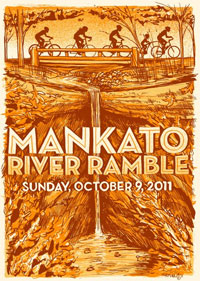 This past weekend Abby and I left the kids with the grandparents and went to Mankato, Minn., for a weekend away. We also took part in the inaugural Mankato River Ramble bike ride. It was a great bike ride with gorgeous fall colors and actually got me to explore Mankato for the first time. I’ve never been to Mankato before (except for maybe driving through on the way to somewhere else), but I was floored by the beautiful river views and waterfalls. I love discovering gems like this so close to home.
This past weekend Abby and I left the kids with the grandparents and went to Mankato, Minn., for a weekend away. We also took part in the inaugural Mankato River Ramble bike ride. It was a great bike ride with gorgeous fall colors and actually got me to explore Mankato for the first time. I’ve never been to Mankato before (except for maybe driving through on the way to somewhere else), but I was floored by the beautiful river views and waterfalls. I love discovering gems like this so close to home.
Growing up as a kid vacations were mostly lengthy affairs that involved loading up the family minivan and driving across the country. We’d see incredible sights but it also took an incredible effort. While I loved those vacations, it’s also left me with the idea that I have to go across the country to see amazing sights. I never quite realize what’s in my own backyard, which is something I’ve been discovering about the Twin Cities and Minnesota since I first moved here more than a decade ago.
Mankato was no exception. We came across not one but two incredible waterfalls (OK, water trickles—it’s been dry lately) and according to the map there are a few more in the area. At times it felt very much like Kansas, with flatness stretching as far as you could see. Our hotel seemed to be on the very edge of city as developments gave way to corn fields. Pickup trucks also ruled the road. But then there were rolling hills and curving rivers—yes rivers, with the confluence of the Minnesota and Blue Earth Rivers, as well as a number of tributaries.
On Saturday morning we took a drive along a river bottom road with signs warning about flooding, falling rock and minimal maintenance. It was beautiful. And empty. We came upon the Minnemishinona Falls and found the place deserted. Didn’t see a soul the entire time we wandered around the footbridge and among the rocks. Later in the day we explored downtown, which didn’t exactly sport a shopping district as advertised, but did have a few unique shops (Mary Lue’s Yarn and Ewe and the Sticks and Stones boutique earned a thumbs up from Abby). We also wandered around Mankato State University just for kicks.
 On Sunday we biked through Minneopa State Park along with the other 1,500 Mankato River Ramble riders and took in the Minneopa Falls. Another trickle, but incredible just the same.
On Sunday we biked through Minneopa State Park along with the other 1,500 Mankato River Ramble riders and took in the Minneopa Falls. Another trickle, but incredible just the same.
We drove home Sunday afternoon (with a stop at Minnesota’s Largest Candy Store) and I couldn’t help but feeling like we’d only scratched the surface of Mankato. There were paths we didn’t follow, restaurants we didn’t get to try and one strange glassed-in door of an old house we never did figure out.
Speaking of old, Mankato also has the history as well. It has the dubious distinction of being the site of largest mass execution in U.S. history when 38 Dakota were hanged for their part in the Dakota uprising of 1862 (303 were sentenced to death but President Abraham Lincoln pardoned 265). This little historical rabbit trail brings up a number of interesting details, including the story of Episcopal Bishop Henry Whipple who argued for leniency, an unpopular stand (to say the least) among settlers who were being slaughtered and wanted justice.
I imagine we’ll come back to ramble around Mankato another time.








